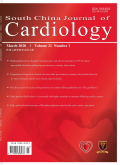- 钛学术文献服务平台 \
- 学术期刊 \
- 医药卫生期刊 \
- 内科学期刊 \
- 岭南心血管病杂志(英文版)期刊 \
Association of MELD-Ⅺ score with adverse events in patients with ST-segment elevation myocardial infarction
Association of MELD-Ⅺ score with adverse events in patients with ST-segment elevation myocardial infarction
基本信息来源于合作网站,原文需代理用户跳转至来源网站获取
摘要:
It is unclear whether the model for end-stage liver disease excluding international normalized ratio(MELD-Ⅺ),in addition to the Thrombolysis In Myocardial Infarction(TIMI)risk score,had prognostic val-ue in patients with ST-segment elevation myocardial infarction(STEMI)undergoing percutaneous coronary inter-vention(PCI).Methods 189 STEMI patients undergoing PCI were consecutively included and classified into two groups based on the cut-off of MELD-Ⅺ,which was determined by receiver operating characteristic(ROC)curve analysis:low MELD-Ⅺ group(<10,n=135)and high MELD-Ⅺ group(≥10,n=54).The association of MELD-Ⅺ with adverse events was analyzed.Results During hospitalization,5(2.6%)patients died,57(30.2%)suffered acute heart failure,4(2.1%)needed renal replacement treatment,2(1.1%)suffered stroke and 1(0.5%)received target vessel revascularization.ROC curve analysis showed that MELD-XI≥10 was an optimal cut-off for predicting in-hospital MACEs[area under the curve(AUC):0.684,95%CI:0.599-769,P<0.001].The in-hospital major adverse clinical events(MACEs)was significantly higher in patients with high MELD-XI(51.9%vs.23.0%,P<0.001).Multivariate analysis showed that MELD-Ⅺ≥10 was an independent risk factor for in-hospital MACEs after adjusting for TIMI risk score(OR:3.59,95%CI:1.79-7.19,P<0.001).Conclusions MELD-XI,in addition to the TIMI risk score,might provide prognostic value for STEMI patients undergoing PCI.

推荐文章
术中配合及护理对ST段抬高型心肌梗死病人介入治疗的应用效果
ST段抬高型急性心肌梗死
经皮冠状动脉介入治疗
术中配合
护理
替罗非班对急性非ST段抬高心肌梗死患者血清肌钙蛋白T水平及近期预后的影响
替罗非班
急性
非ST段抬高心肌梗死
肌钙蛋白T
急性心肌梗死经皮腔内冠脉介入治疗后心电图 ST 段回落不良与临床预后的关系研究
急性 ST 段抬高型心肌梗死
经皮腔内冠脉介入治疗
STR
临床预后
心脏功能
MELD、MELD-Na、SOFA评分系统对肝衰竭短期预后的价值
肝功能衰竭
预后
终末期肝病模型
MELD-Na模型
序贯器官衰竭估计
内容分析
关键词云
关键词热度
相关文献总数
(/次)
(/年)
文献信息
| 篇名 | Association of MELD-Ⅺ score with adverse events in patients with ST-segment elevation myocardial infarction | ||
| 来源期刊 | 岭南心血管病杂志(英文版) | 学科 | |
| 关键词 | |||
| 年,卷(期) | 2021,(2) | 所属期刊栏目 | CLINICAL STUDIES |
| 研究方向 | 页码范围 | 75-79 | |
| 页数 | 5页 | 分类号 | |
| 字数 | 语种 | 英文 | |
| DOI | |||
五维指标
引文网络
引文网络
二级参考文献 (0)
共引文献 (0)
参考文献 (8)
节点文献
引证文献 (0)
同被引文献 (0)
二级引证文献 (0)
2000(1)
- 参考文献(1)
- 二级参考文献(0)
2012(1)
- 参考文献(1)
- 二级参考文献(0)
2015(1)
- 参考文献(1)
- 二级参考文献(0)
2016(1)
- 参考文献(1)
- 二级参考文献(0)
2018(3)
- 参考文献(3)
- 二级参考文献(0)
2019(1)
- 参考文献(1)
- 二级参考文献(0)
2021(0)
- 参考文献(0)
- 二级参考文献(0)
- 引证文献(0)
- 二级引证文献(0)
引文网络交叉学科
相关学者/机构
期刊影响力
岭南心血管病杂志(英文版)
主办单位:
广东省心血管病研究所
出版周期:
季刊
ISSN:
1009-8933
CN:
44-1512/R
开本:
大16开
出版地:
广州市东川路96号二楼233室
邮发代号:
46-243
创刊时间:
2000
语种:
eng
出版文献量(篇)
771
总下载数(次)
0
期刊文献
相关文献
推荐文献
- 期刊分类
- 期刊(年)
- 期刊(期)
- 期刊推荐
岭南心血管病杂志(英文版)2021
岭南心血管病杂志(英文版)2020
岭南心血管病杂志(英文版)2019
岭南心血管病杂志(英文版)2018
岭南心血管病杂志(英文版)2017
岭南心血管病杂志(英文版)2016
岭南心血管病杂志(英文版)2015
岭南心血管病杂志(英文版)2014
岭南心血管病杂志(英文版)2013
岭南心血管病杂志(英文版)2012
岭南心血管病杂志(英文版)2011
岭南心血管病杂志(英文版)2010
岭南心血管病杂志(英文版)2009
岭南心血管病杂志(英文版)2008
岭南心血管病杂志(英文版)2007
岭南心血管病杂志(英文版)2006
岭南心血管病杂志(英文版)2005
岭南心血管病杂志(英文版)2004
岭南心血管病杂志(英文版)2003
岭南心血管病杂志(英文版)2002
岭南心血管病杂志(英文版)2001
岭南心血管病杂志(英文版)2000

 免费查重
免费查重










